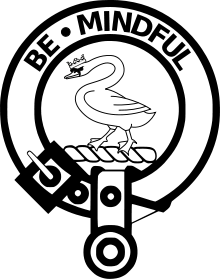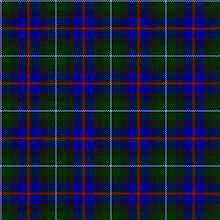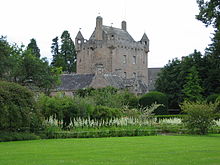- Clan Campbell of Cawdor
-
 Crest badge suitable to be worn by members of Clan Campbell of Cawdor.
Crest badge suitable to be worn by members of Clan Campbell of Cawdor.
Clan Campbell of Cawdor is a highland Scottish clan. While the clan is recognised by the Standing Council of Scottish Chiefs, the clan does not have a clan chief recognised by the Standing Council of Scottish Chiefs.[1] Also, because the clan does not have a clan chief recognised by the Lord Lyon King of Arms it is considered an armigerous clan.[2]
In 1510, Muriel, daughter of John, 7th Thane of Caddell (or Calder), married Sir John Campbell, third son of the 2nd Earl of Argyll. From 1524 to 1546, Sir John Campbell of Caddell lived at Caddell Castle, until his death. After Muriel's death in 1573, the Thanedom was resigned in favour of her grandson, John Campbell. In the 17th century, Sir John Campbell of Caddell sold Croy and disposed of Ferintosh to Lord Lovat, in order to buy the Isle of Islay. Islay was held by the Campbells of Caddell from 1612-1726 when it was bought by Daniel Campbell of Shawfield. Sir John Campbell, 8th of Caddell, married Mary, eldest daughter of Lewis Pryce (or Pryse) of Gogerddan in Cardiganshire. Campbell of Cawdor died in 1777 and was succeeded by his son, Pryse Campbell of Caddell, who was a MP for Cromartyshire and Nairnshire. His son, John, was made Lord Caddell of Castlemartin in 1797. On his death in 1821, he was succeeded by his son, John Fredrick Campbell, 1st Earl of Cawdor.[1] From the 1st Earl of Cawdor descend the Earls of Cawdor. (Source: records of the Scottish Privy Council, 1613–1616)
The name "Cawdor" is the English pronunciation and spelling of the ancient and original name of Caddell. In the lowlands, the name was pronounced Calder, so that if someone moved from the highlands to Edinburgh, their name would change from Caddell to Calder. In the early 19th century, Lord John Campbell of Caddell was residing in England and changed the name of the castle, town and clan overnight so that it would match the Shakespearian designation (reference: Cawdor Historical Society).
 The Campbell of Cawdor tartan is one of several tartans officially authorised by the chief of Clan Campbell.
The Campbell of Cawdor tartan is one of several tartans officially authorised by the chief of Clan Campbell.
A modern clan member's crest badge contains the heraldic motto: BE MINDFUL.[1] The Campbell of Cawdor tartan is very similar to other "Campbell" tartans. This tartan did not originally have a name, until it was called an "Argyle" tartan in 1789. It wasn't until W. and A. Smith's book was published, in 1850, that was this tartan actually named "Campbell of Cawdor".[3] The Campbell of Cawdor tartan is one of only four tartans officially authorised by the current chief of Clan Campbell, Torquhil Campbell, 13th Duke of Argyll.[4] Frank Adam and Thomas Innes of Learney, in their The Clans, Septs & Regiments of the Scottish Highlands, listed several septs for Clan Campbell of Cawdor. These were: Caddell and Calder. Adam and Innes of Learney also wrote that the Campbells of Cawdor were described as "de Cadella".
Names and Spellings of Names connected with Clan:
Associated Names and Septs (with spelling variations): Cadall Caddel Caddell Cadder Cadell Cadella Caldaile Caldell Calder Caldor Cambal Cambale Cambel Cambele Cambell Cambelle Camble Cammell Campbele Campbell Campbill Campble Cattal Cattall Cattell Cattle Cauder Caudle Caulder Cawdale Cawdor Chambelle Cowdale Kambail Kambaile Kambayl Kumpel O'Docharty Torie Torrie Torry
See also
- Clan Campbell
- Clan Calder
- Cawdor Castle
- Earl of Cawdor
- Armigerous clan
References
- ^ a b c d "Clan Campbell of Cawdor". Standing Council of Scottish Chiefs (clanchiefs.org). http://www.clanchiefs.org/?init=clanfinder&id=Campbell%20of%20Cawdor. Retrieved 2008-05-03.
- ^ "Tartan - Campbell of Cawdor". Scottish Tartans World Register (scottish-tartans-world-register.com). http://www.scottish-tartans-world-register.com/tartan.aspx?record=2. Retrieved 2008-11-03.
- ^ "Which are the authentic Campbell tartans?". Clan Campbell Society, North America (ccsna.org). http://www.ccsna.org/jsep50a.htm. Retrieved 2008-05-04.
- ^ Adam, Frank; Innes of Learney, Thomas (1970). The Clans, Septs & Regiments of the Scottish Highlands (8th edition ed.). Edinburgh: Johnston and Bacon. p. 302.
External links
- "THE CAMPBELLS OF CAWDOR". Extract from The Great Historic Families of Scotland, By James Taylor, M.A., D.D., F.S.A and published in 1887, found on burkes-peerage.net
- Clan Campbell Society, North America
Clan Campbell Branches Campbell of Argyll · Campbell of Breadalbane · Campbell of Cawdor · Campbell of Glenorchy · Campbell of Loudoun · Campbell of Possil · Campbell of Strachur · Campbell of AuchinbreckLands Castles Inveraray Castle · Castle Campbell · Kilchurn Castle · Edinample Castle · Carnasserie Castle · Saddell Castle · Finlarig Castle · Torosay Castle · Taymouth Castle · Cawdor Castle · Balloch CastleScottish clans Clans with chiefs Agnew · Anstruther · Arbuthnott · Arthur · Bannerman · Barclay · Borthwick · Boyd · Boyle · Brodie · Broun · Bruce · Buchan · Burnett · Cameron · Campbell · Carmichael · Carnegie · Cathcart · Charteris · Chattan · Chisholm · Cochrane · Colquhoun · Colville · Cranstoun · Crichton · Cumming · Darroch · Davidson · Dewar · Drummond · Dunbar · Dundas · Durie · Elliot · Elphinstone · Erskine · Farquharson · Fergusson · Forbes · Forsyth · Fraser · Fraser of Lovat · Gayre · Gordon · Graham · Grant · Gregor · Grierson · Guthrie · Haig · Haldane · Hamilton · Hannay · Hay · Henderson · Home · Hope · Hunter · Irvine · Jardine · Johnstone · Keith · Kennedy · Kerr · Kincaid · Lamont · Leask · Lennox · Leslie · Lindsay · Lockhart · Lumsden · Lyon · MacAlister · MacBain · MacDonald · Macdonald of Clanranald · MacDonald of Keppoch · Macdonald of Sleat · MacDonell of Glengarry · MacDougall · Macdowall · MacIntyre · Mackay · Mackenzie · Mackinnon · Mackintosh · Maclachlan · Maclaine of Lochbuie · MacLaren · MacLea (Livingstone) · Maclean · MacLennan · MacLeod · MacLeod of Lewis · MacMillan · Macnab · Macnaghten · MacNeacail · MacNeil · Macpherson · MacTavish · MacThomas · Maitland · Makgill · Malcolm (MacCallum) · Mar · Marjoribanks · Matheson · Menzies · Moffat · Moncreiffe · Montgomery · Morrison · Munro · Murray · Napier · Nesbitt · Nicolson · Ogilvy · Oliphant · Primrose · Ramsay · Rattray · Riddell · Robertson · Rollo · Rose · Ross · Ruthven · Sandilands · Scott · Scrymgeour · Sempill · Shaw · Sinclair · Skene · Spens · Stirling · Strange · Stuart of Bute · Sutherland · Swinton · Trotter · Urquhart · Wallace · Wedderburn · Wemyss · Wood ·
Armigerous clans Abercromby · Abernethy · Adair · Adam · Aikenhead · Ainslie · Aiton · Allardice · Anderson · Armstrong · Arnott · Auchinleck · Baillie · Baird · Balfour · Bannatyne · Baxter · Bell · Belshes · Bethune · Beveridge · Binning · Bissett · Blackadder · Blackstock · Blair · Blane · Blyth · Boswell · Brisbane · Buchanan · Butter · Byres · Cairns · Calder · Caldwell · Callender · Campbell of Breadalbane · Campbell of Cawdor · Carruthers · Cheyne · Chalmers · Clelland · Clephane · Cockburn · Congilton · Craig · Crawford · Crosbie · Cunningham · Dalmahoy · Dalrymple · Dalzell · Dennistoun · Don · Douglas · Duncan · Dunlop · Edmonstone · Fairlie · Falconer · Fenton · Fleming · Fletcher · Forrester · Fotheringham · Fullarton · Galbraith · Galloway · Gardyne · Gartshore · Ged · Gibsone · Gladstains · Glas · Glen · Glendinning · Gray · Gunn · Haliburton · Halkerston · Halket · Hepburn · Heron · Herries · Hogg · Hopkirk · Horsburgh · Houston · Hutton · Inglis · Innes · Kelly · Kinloch · Kinnaird · Kinnear · Kinninmont · Kirkcaldy · Kirkpatrick · Laing · Lammie · Langlands · Learmonth · Little · Logan · Logie · Lundin · Lyle · MacAulay · Macbrayne · MacDuff · MacEwen · MacFarlane · Macfie · Macgillivray · MacInnes · MacIver · Mackie · MacLellan · Macquarrie · Macqueen · Macrae · Masterton · Maule · Maxton · Maxwell · McCorquodale · McCulloch · McKerrell · Meldrum · Melville · Mercer · Middleton · Moncur · Monteith · Monypenny · Mouat · Moubray · Mow · Muir · Murray of Atholl · Nairn · Nevoy · Newlands · Newton · Norvel · Ochterlony · Orrock · Paisley · Paterson · Pennycook · Pentland · Peter · Pitblado · Pitcairn · Pollock · Polwarth · Porterfield · Preston · Pringle · Purves · Rait · Ralston · Renton · Roberton · Rossie · Russell · Rutherford · Schaw · Seton · Skirving · Somerville · Spalding · Spottiswood · Stewart · Stewart of Appin · Strachan · Straiton · Strange · Sydserf · Symmers · Tailyour · Tait · Tennant · Troup · Turnbull · Tweedie · Udny · Vans · Walkinshaw · Wardlaw · Watson · Wauchope · Weir · Whitefoord · Whitelaw · Wishart · Young
Culture and society Scotland · Clan chief · Septs · Clan badge · Clan crest · Clan battles · Tartan · Bagpipes · Clearances · Kilt · Manrent · The Highlands · Battle of Culloden · Highland games · Border Reivers · Scottish heraldry · Scottish surnames
Categories:- Scottish clans
- Armigerous clans
- Clan Campbell
Wikimedia Foundation. 2010.

